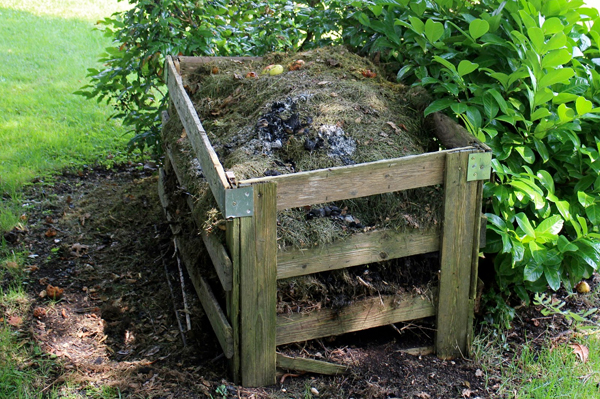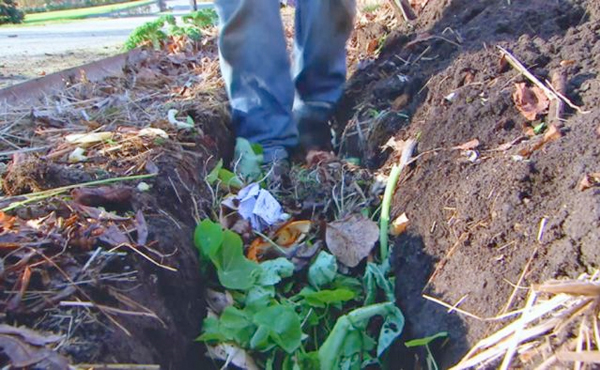
Chapter 24
Composting
One of the requirements for growing tomatoes is the need for significant amounts of organic matter in the soil. A major source of organic matter for the garden is compost. Compost can be purchased in bags, obtained at a compost center, or made at home. Homemade compost offers the advantage of knowing exactly what went into making it. Most gardeners either have, or would like to have, a compost pile. Only a few of them actually have an understanding of the composting process and the ingredients required to build an active compost pile. The following is a brief review of compost making and one system, of the many available that can be used by a home gardener.

First, some definitions are in order. Compost is defined as decomposed and partially decomposed organic matter which can include such things as leaves, grass clippings, dead weeds, garden waste, sawdust, or animal manure. Compost is considered to be a soil amendment and not a fertilizer since it contains very little readily available NPK (major plant nutrients) until it is further broken down by soil organisms. Composting is defined as the rapid decomposition of crude organic material by biological organisms under controlled and sometimes not so controlled conditions.
Compost opens and loosens the soil thereby allowing roots to penetrate more readily. Compost retains water yet it drains well. It also improves air circulation in soil thus allowing needed oxygen to penetrate to the roots. It increases soil bacterial activity which results in further breakdown of the compost itself, and as a result, helps release nutrients into the soil. Compost also balances soil pH by acting as a buffer. In addition, it increases soil nutrient retention by increasing the cation exchange content of the soil. Compost can also immobilize soil toxins (heavy metals) by binding them.
There are millions of bacteria in one bucket of topsoil. One of these organisms under the right circumstances can multiply to 2 million in 7 hours. Soil microorganisms break down raw organic material by eating it. In this process, they release plant nutrients that were locked up in the organic matter, N, P, K, Ca, Mg, and trace elements. As the bacteria grow and multiply, they take in oxygen and give off heat. To do this they need an energy source (carbon), a protein source (nitrogen), water, oxygen (aerobic organisms break organic matter down more rapidly and completely), and warmth. All of these must be present for composting to take place in any successful compost pile. Carbon materials and nitrogen should also be present in the right ratio to have maximum composting occur. The ideal ratio of carbon to nitrogen in a new compost pile is 30 to 1.
Common compost materials, essentially food for microorganisms, include leaves (high in carbon), grass (high in nitrogen), straw (high in carbon), sawdust (very high in carbon), weeds (medium in nitrogen if green), and manure (high in nitrogen). Along with food for the bacteria, other requirements for composting include proper moisture (40% to 60%), microorganisms, which can be added to the pile by putting in some soil or old compost, and oxygen. As noted, the carbon to nitrogen ratio should be around 30:1. This means you should add more leaves, preferably chopped, or straw than grass or manure to the pile, since the former are high in carbon and the latter high in nitrogen. Oxygen is added by either turning the pile or running pipes through the pile to allow the entry of outside air.
Typical C:N ratios of compost material
| Material | C:N Ratio |
| Sawdust | 400:1 |
| Paper | 100:1 |
| Straw | 100:1 |
| Oak leaves | 50:1 |
| Maple leaves | 50:1 |
| Hay | 25-50:1 |
| Ideal raw compost | 30:1 |
| Grass | 25:1 |
| Weeds | 20:1 |
| Horse manure | 15:1 |
| Cow manure | 15:1 |
| Mature compost | 15:1 |
| Alfalfa hay | 12:1 |
| Poultry manure | 7:1 |
The amount of carbon to nitrogen in a compost pile determines the rate of decomposition. If the C:N is high, the breakdown is slow. If the C:N is low the breakdown is more rapid, but nitrogen escapes the pile.

Understanding the stages of composting is important in understanding the nutritional value of the compost. There are four stages of composting as follows:
1. Degradation: In this stage there is rapid bacterial growth in the compost with carbohydrates and proteins being eaten. The compost pile temperature will be 140˚ to 160˚. The C:N ratio of the compost at this stage is 30:1.
2. Conversion: The pile cools and low temperature bacteria, fungi, and actinomycetes, take over the organic material breakdown process. There is a further drop in the carbon content of the pile. At this point the compost is referred to as raw compost. If this compost is put into the garden now, it would initially deplete the soil nitrogen as it breaks down further. The C:N ratio of the compost pile is now 20:1.
3. Curing: The compost pile temperature cools to air temperature. The bacteria continue their activity. Bugs and worms invade the pile. The compost is now referred to as mature compost. It is ideal for the garden. The C:N ratio at this point is15:1.
4. Aged Compost: There is a continued breakdown of organic matter. The compost begins to lose its nutritient value. The C:N ratio is 10:1 to 12:1 now. The C:N ratio of humus, which has minimal nutrient value, is 10:1. The compost has nearly broken down to humus.
.jpg)
Mature compost is dark in color. It is crumbly and easy to pulverize with your fingers. It smells sweet and earthy. The compost materials in the pile have lost their identity. The pile has been reduced in volume and weight by more than 50%. The internal temperature of the compost pile is the same as the outside air, and if turned the temperature does not exceed 110˚. The C:N ratio is 15:1.

Composting can range from passive – allowing materials to sit and rot on their own – to highly managed with frequent pile-turning and watering, requiring more time and effort. The choice is yours. Active composting results in a more rapid breakdown of the organic materials.

Although there are many ways in which you may compost, I recommend a combination of two of them for tomato growers – first, the use of a simple, passive compost pile, followed by sheet composting. A simple compost pile can be built in the fall and then added to the garden the following fall. Collect chopped leaves and add to them either grass clippings or animal manure (cow or horse), and make a pile at least 4 feet high, positioning it close to your garden. Build the pile in 6 inch layers by first adding some leaves and grass clippings, then manure, and finally, some soil from your garden or old compost. The leaves add carbon, the grass nitrogen, and the soil, or old compost, bacteria. If you are low on nitrogenous materials, add some alfalfa meal to the pile. Put your pile where you can reach it with a truck and where water is accessible. Try to build the pile in the shade on a level spot with good drainage and protection from the wind.

After the pile is complete in the fall, water it, and then cover it with a tarp if you have one available. Once in awhile, remove the tarp if it is raining to add moisture, or water it with a hose. If you feel energetic, you may turn the pile with a fork in the early spring and late summer, or if you choose, you can just let it sit.

The following fall, after the pile has been sitting and composting for a year, complete the composting by using the technique of sheet composting. Sheet composting amounts to spreading your last year's compost pile over the garden in a layer 2 to 6 inches thick and then tilling it into the first 6 inches of the soil. By the following spring, most of the organic material will have broken down so that the original materials will not be recognizable. Additional organic matter can be added in the spring, including fresh manure, but it should be done at least 6 weeks prior to planting and no more than a 2 inch layer should be added. Fall additions of organic matter to the garden are recommended, and spring additions should be done only out of necessity.

You can also practice a method called trench composting. In this method, you dig a trench adjacent to your row of tomato plants. Throughout the season, you fill it with garden refuse and other materials mentioned above – adding the soil you excavated as you build up the trench. The following season, you move your row of tomatoes to the trench row.
All compost is not nutritionally the same. Quality depends on the materials added to the compost pile. Municipal compost is often of poor quality having been made quickly of paper, wood, sawdust, and leaves. It may have a C:N well above 15. It may include some chemicals that were sprayed on the organic material used to make the compost. You will be much better off making and using your own compost if it is possible to do so.